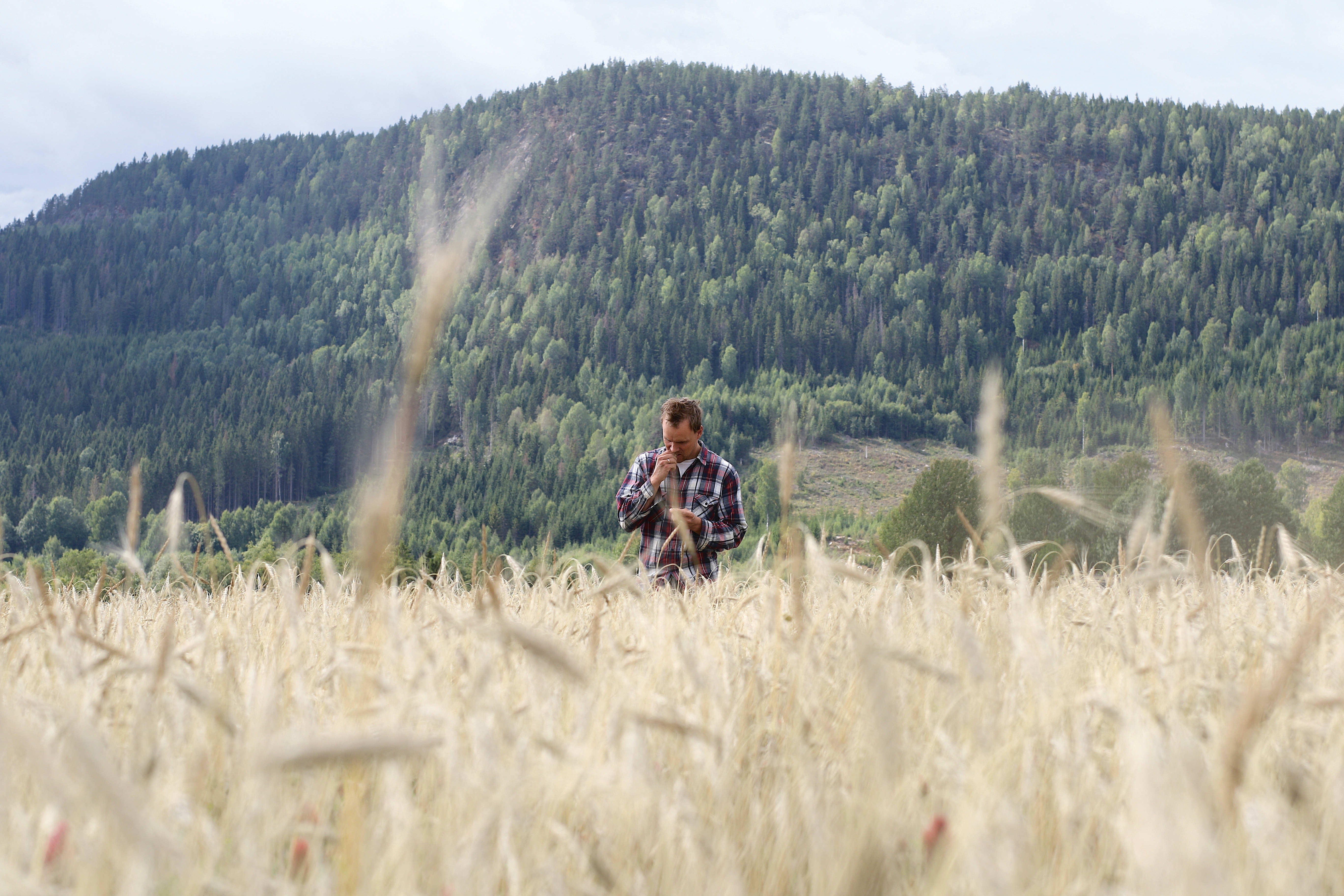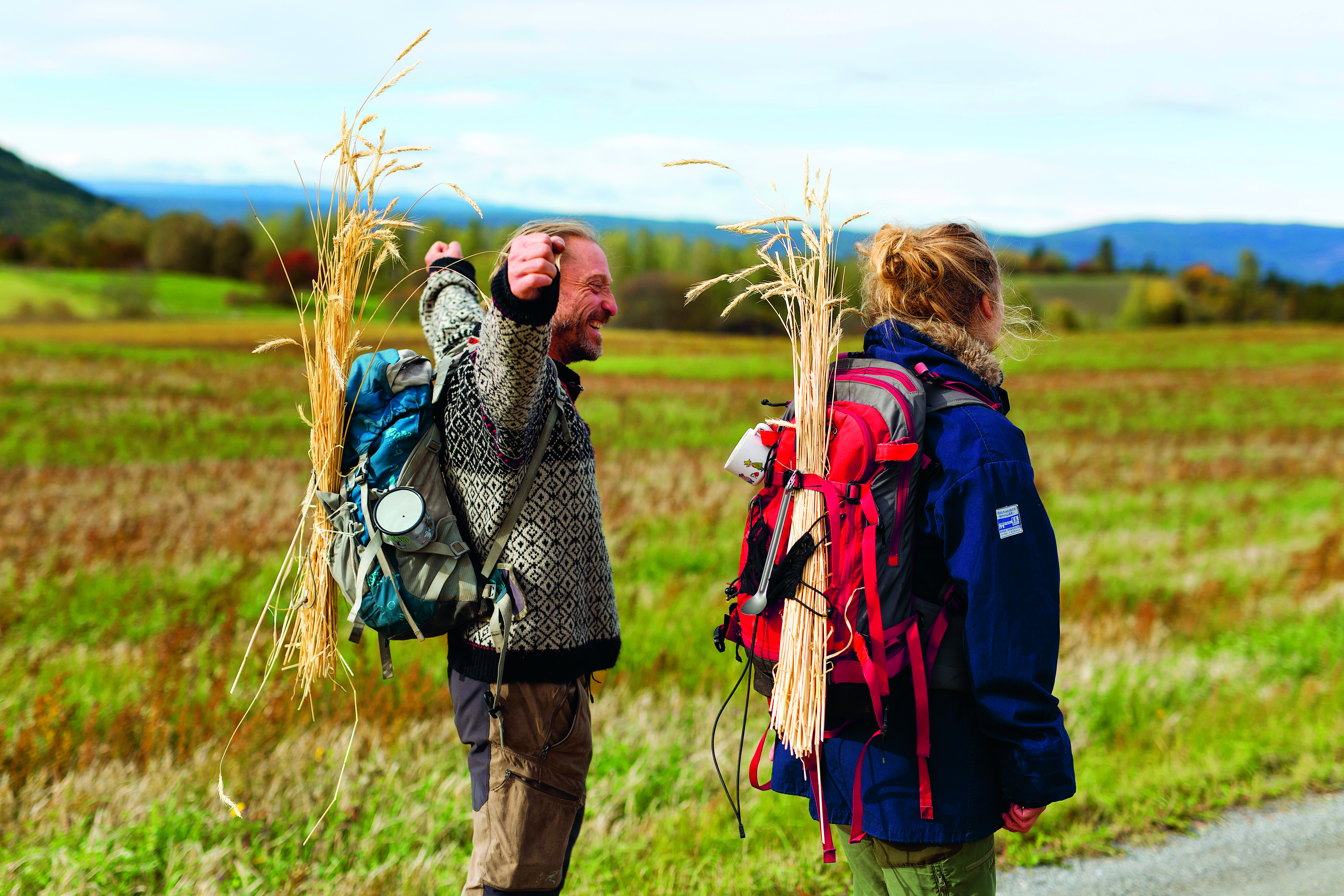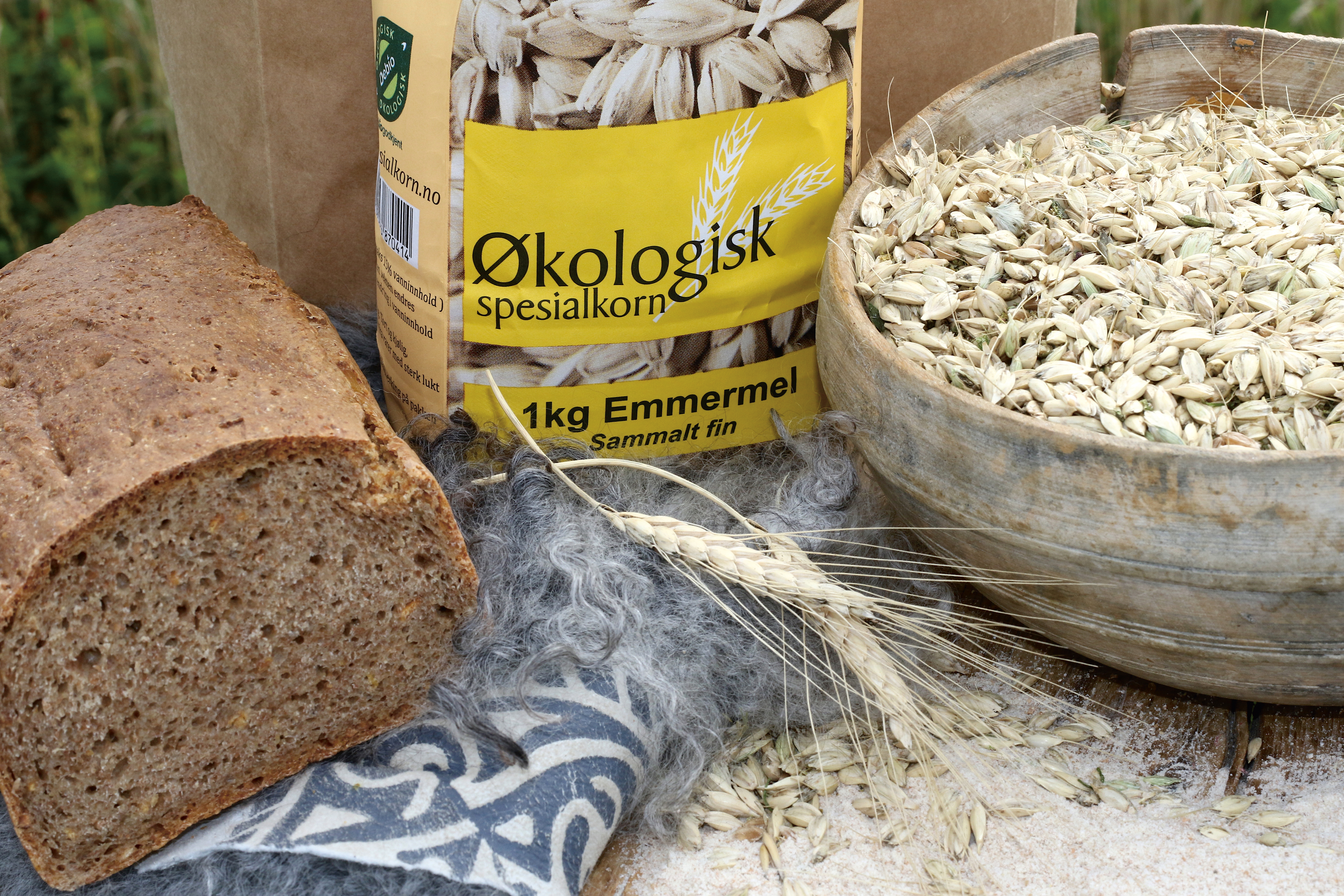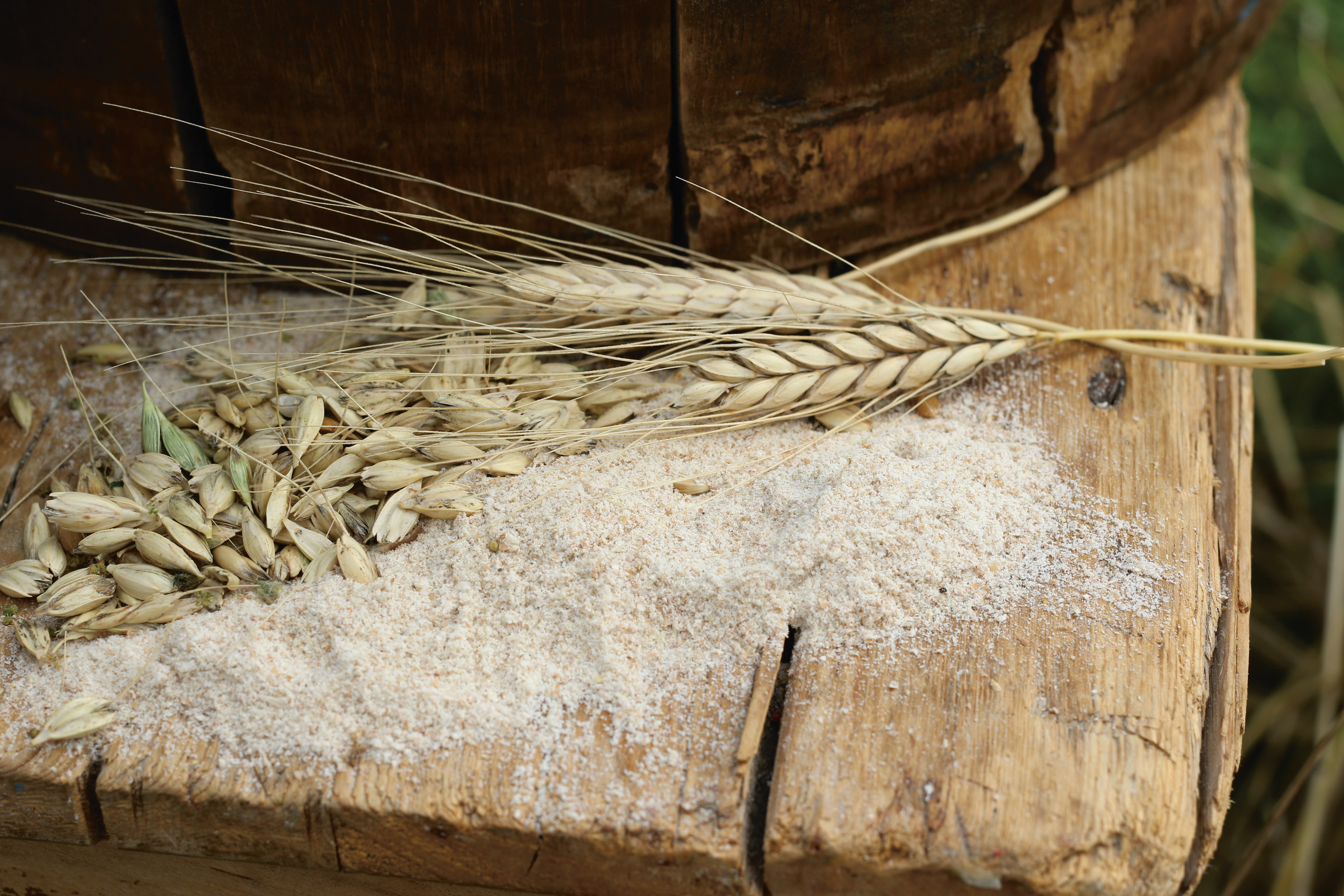Column
The Domestication of
— A Wild Grain
The Walk
Step by step they carefully bring a selection of different bread and grains from the city to the countryside. If you want to preserve a seed, you plant it. This is exactly what they are doing. (Well, they first have to grow it.) The process flows from seeding them, caring for them, harvesting them, grinding them, and then, after all the hard work, comes eating them. But before we begin walking, let us spend some time on the taste.
The Taste
Have you ever tasted freshly baked bread of emmer? With an aroma reminiscent of nuts paired with a soft but firm consistency, a bite of emmer bread will transport you to a late summer evening amongst the high green grains as they slowly fade to yellow. More and more, we see people embrace a diverse spectrum of grains and baking methods, leaving behind the standardized, less flavourful bread. And Losæter is leading the crusade.
The Last Breakfast
Early on a Wednesday morning in September, we met up for breakfast in the Bakehouse at Losæter—the most urban sæter, or pasture, you will ever know. On top of a tunnel in the middle of Oslo, Losæter can be seen as the most vital blood vein in the body of urban agriculture in Norway. Where your usual small city farm experiment, with requisite tomatoes and cucumbers, this urban farmscape comes with its own field of grains—a result of a long-term collaboration, a cooperative called Økologisk Spesialkorn (meaning ‘organic special grains’), with Johan Swärd and Anders Næss. Swärd and Næss are two of the most prominent Norwegian producers of wild grains. Norwegians tend to see breakfast as the most important meal of the day—and a “must” before any long walk. This breakfast was organized as a last gathering before the long walk from Losæter began. FURTHER ON … TO LAND marks the culmination of a 7-year-old public art project called Flatbread Society, led by the international artist group Futurefarmers on behalf of Bjørvika Utvikling. At the heart of this walk is an intention to keep the connections between the urban and rural agrarian practices alive. The slow pace of walking harnesses the ethos of intention behind the artwork at Losæter. Futurefarmers promotes the slow way—of growing and making food—and they always shed light on the life-giving work of the farmers who feed us.
The Farmers
The purpose of urban agriculture is not only to produce food, but to communicate the effort. “The grain field at Losæter is a demonstration field, cultivating seeds that have been ‘rescued’ from various locations in the Northern Hemisphere. Planted in a public space, these seeds display thousands of years of a complex, hand-to-hand network of knowledge and genetic resources”, Amy explains. The seeds saved are, what we call, ancient grains. Ancient grains farmer, Anders Næss, has been involved in the grain field at Losæter from the very beginning—focusing on soil health, as much as the growth of the grains themselves.
“Not everything that is old is worth taking care of”, Anders says, “but some classics are worth more than gold!” This is how Anders, and the other farmers in Økologisk Spesialkorn operates. Land species, also known as cultural grains or original grains, have one thing in common. For thousands of years, farmers all over the world have selected the best seeds, the most solid heads of grain, and the grains that embody preferable traits.
In this way, grains have evolved, developing unique characteristics and adaptations to local conditions. “Farming is not just a physical act; it´s political! No one can claim to own the right to this plant material. It is our common heritage”, Amy proclaims. Some of the grain varieties have exceptionally good properties—for the farmer growing them, those processing them and those enjoying them. It’s no wonder they have staying power, despite being thousands of years old.
Memorable Emmer
Økologisk Spesialkorn sells flour and whole grains, and emmer is one of the favorites. Emmer is amongst the oldest grains of the Nordic countries. Its origins trace all the way back to the earlier Stone Age some 8000 years ago. Emmer, or tokornkveite, is a type of wheat. It has 28 chromosomes and two seeds in every head of grain. It has a softer gluten than, for example, spelt. This is due to the fact that emmer has been a part of the evolutionary chain long before spelt arrived. Wild emmer differs from the modern strain by the behavior of the seeds. While the ripened seed head of a wild emmer plant crushes and spreads its seeds into the surrounding soils, the seed head of a domesticated species remains intact for the farmer to harvest. Archeology has found that wild emmer can be traced as far back as 17,000 BC. It was eaten by hunter-gatherers long before it was domesticated by farmers and scientists. Emmer was the most common grain in ancient Egypt, and, if you happen to be an archeologist, your chances of finding emmer in a West Asian tomb are pretty high.
Living Soil And Healthy People
From prehistoric hunter-gatherers to contemporary farmers, the seeds of edible plants have been passed on over generations. The grains may have a different genetic make-up, but the process for how to farm them has remained consistent for thousands of years—plant seeds, care for the soil, add water and sun, repeat. “The symbioses between the plants, the soil and all life forms in the soil is the foundation for our life and health”, explains Anders Næss. “We grow certified organic ancient grains, because organic agriculture is the future of farming. If you want plants with high nutritional density, the potential is enormous when it comes to the understanding and use of soil for plants”.
No wonder Økologisk Spesialkorn´s slogan is, “We grow organic because nature is always a little bit smarter”. The company´s holistic understanding of the world centers around one main thought—that we have to cooperate with nature, rather than control it. “As an organic farmer, you have to take good care of your soil in order for it to deliver produce of good quality, not only today and tomorrow, but in indefinitely into future”, says Anders.
Soil science may not be the first thing you think of when you hear “dinner is served”, but it should be! The ability of grain and soil to provide high quality food actually depends on the adequate supply of organic matter in the form of compost and organic fertilizer. At the same time, an active and biological diversity of microorganisms must be present in the soil to make the nutrients available to the plants. No field of emmer would grow without the exchange of nutrients between living organisms and plants. This activity is crucial for building humus—the organic matter in soil essential for building fertile soil structures. These are basic processes in nature that create a fertile soil. This is a prerequisite for healthy plants, animals and humans.
The Mill
We have a saying in Norway—fra jord til bord, or the familiar English-ism “from field to fork”. But the story of bread is circular. The story of bread starts from seeds through soil and taking root as a plant. It follows through harvesting by farmers, grinding in the mill, shaping by a baker, and before it becomes a part of a human body. It could be yours or it could be mine. Through the energy the bread provides, we can repeat this action, collecting new seeds and sowing a new field. The actual transformation of crispy grain to soft flour takes place at the mill. The farmers in Økologisk Spesialkorn take part of the entire lifecycle of their grains, leaving no stages in the production to chance. “We have our own mill in the county of Buskerud, in a place called Sigdal”, Anders explains. “And we are proud to be the first Norwegian company certified as a producer of preserved varieties. Our goal is that both farmers and consumers will have the opportunity to enjoy a diverse selection of these historical grains. Not just today, but also in the future”. Emmer and the other species go through a stone grinder, making sure that all the nutrients remain intact. In Økologisk Spesialkorn´s mill emmer is only one kind among what they produce – their varieties of ancient grains span from spelt, emmer and einkorn to svedjerug, (ancient rye), hulless barley and other landraces of wheat.
The Ancient Ones
Let us throw some facts in the bread basket. These ancient grains… what are they really? Well, emmer and the other species we call ancient are a group of grains that has gone through less genetic intervention than, for example, rice, corn and many varieties of wheat. Field selection as a method of breeding has been a big part of agricultural evolution. Field selection is marked by an interaction between nature and humans, governed by nature. This is in stark contrast to modern breeding where humans try to control nature. The aim of modern wheat breeding (especially in Norway after WWII) has been increased yields and efficiencies in technical and industrial processing quality. “Nutrition and taste has not been the aim”, Anders explains. “Nofima, the Norwegian Institute of Food Research, has measured that the content of Fe (iron) and Mg (magnesium) in our Emmer was twice the amount found in, for example, one of the most modern wheat varieties in Norway called Mirakel”, Anders continues.
The most commonly grown grains in Norway are oats, barley, rye and wheat. They each have their own genetic and geographical history, passing through the hands of farmers and, more recently, into the hands of researchers. Oats have spread from West Asia, and, throughout history, were best known as horse fodder for the Roman cavalry. Oats do not contain any gluten and possess very poor baking characteristics on their own. Therefore, they must be supplemented with other grains to be used to bake bread. On another note, oats do contain a large proportion of beta-glucans that researchers believe help prevent cardiovascular disease. You have all eaten some sort of flatbread (or at least we know that the artists in Flatbread Society have). Barley used to be the most commonly used baking grain in Norway. Barley contains gluten and has a distinct, slightly bitter taste. Then there is rye—the last of the most common grain varieties—but also an ancient grain. Barley gives your bread a dark color and has a slightly sour taste. Now we see our basket is full of grains with different tastes and different characteristics.
The Bakehouse
All over the world, we eat bread all day long. In the hands of bakers, these ancient grains are no longer plants in a field or flour in the mill. Bakers transform emmer and other grains into edible experiences, good for breakfast, lunch, dinner or a snack. Emmanuel Rang is one of the bakers at Losæter. The bakehouse is a public baking facility and an experimental architectural structure with a multi-functional oven. It is quite a sight. Emmanuel was drawn to the place because of the ripe possibility of making real connections. Not just with interesting people and good food, but the direct connection between farming and baking—or, to be more precise, between farmers and bakers. Emmanuel has been working in the bakehouse at Losæter, and now he is ready to leave. He is actually walking away step-by-step, together with Futurefarmers. Emmanuel brings all of his experiences from Losæter with him, as he seeks to collaborate with more farmers. It’s time to bake new bread. For the artists, this is not a departure but a decollage—a migratory act. They will return from their pilgrimage.
“The framework of grain production and use of grains is so stiff “, Emmanuel explains. As a co-founder of Åpent Bakeri, one of the biggest bakeries in Norway, Emmanuel has worked with producers and bakers like Gullimunn and Økologisk Spesialkorn. He has spent a lot of time within the complex landscape of grain production and baking. But he is hungry for more, for something different.
Emmanuel stretches out his arms as far out to each side as possible, demonstrating the broad range of opportunities ahead. “There are so many opportunities when it comes to grains and baking. But we have adjusted the grains to our needs, thinking we will end up with better foods. But, in reality, we have narrowed down the use, the taste and the people. The industrial use of grains has its limits”. The palms of his hands meet. “We are using only a small part of the grains´ potential. If the grains are not suitable for bread, let us use it for something else. Crisp bread or pancakes. Let the grain decide what it can be!”
If you are looking for a baker that has risen to the challenge of getting to know the distinct personalities of grains, Emmanuel is your go-to-guy. His curriculum vitae contains experiments such as baking 14 breads with the same recipe, but with 14 different grains from 14 different farms, just to experience the wide range of qualities. That’s what you call a real hunger for knowledge!
Enzymatic Magic
Grains can be used for so much. At this point, we’ve learned that flour from ancient grains often has a different flavour than your run-of-the-mill (get it?!) supermarket flour. But what about the baking quality? The protein, or gluten, in emmer demands a custom baking technique, like cold-raised dough or use of a sourdough. Emmer is a highly nutritious grain, rich in fibre and a light gluten. Time and patience are key ingredients to preparing good foods, and harder grains, such as emmer, need time to rise. Enzymes compose a big part of the science and art of baking. Enzymes are a type of protein found in all raw foods. They are necessary components of all cells in our body, as they break down nutrients for us to take advantage of them. Enzymes, and especially the ones we call amylase, are crucial for baking because they cleave starch and nourish the yeast. Ancient grains have a lower gluten content than modern wheat varieties. These modern varieties have been coaxed to meet the demands of industrial baking where fast rising dough and strong binding capacities are a must.
Through The Tandoor
The bakehouse at Losæter is not just a space for production; it is a meeting point for urbanites interested in real food. The oven in the bakehouse remains an important instrument. This is where the bread in the wooden backpack was baked—the bread that Futurefarmers and Emmanuel brought to the farm. But, before the baker and the artists started to walk away from Losæter, the bakehouse hosted another important event… let us move through the tandoor. Over a weekend, just before the long walk began, the bakehous welcomed a contingency of local, national and international bakers. During this time, they all shared their recipes and techniques. They prepared everything from lefse and flatbreads, to naan and tortillas—all of them going through the stone oven. The grain continues to travel. It has gone through the tandoor and now it goes forth. Futurefarmers and Emmanuel carry it on their backs further onto land, all the way up to the farm of Vestre Aschim in Brandbu, in the eastern part of Norway. This is only the beginning. Emmanuel will bake and travel, visiting many different farmers, using different ovens and baking facilities. He will both spread his knowledge and learn along the way. In the coming years, Emmanuel will bake, restore ruined bakehouses and exchange with those he meets.
The Farmer And The Future Farmers
Amy Franceschini looks like a peacock, with axes of grain waving out from her backpack over her head. Soft like feathers. Flatbread Society at Losæter is a social art project. The art is more than communicating someone´s knowledge, more than the act and science of urban agriculture. Futurefarmers in Flatbread Society aim to knead relations by nurturing a complex ecology of disciplines, producing new knowledge and new experiences in the process. They have worked at Losæter since 2011. Grain has held a special place in this common home since the beginning. Futurefarmers call it “…a prismatic impetus to consider the interrelationship of food production to realms of knowledge sharing, cultural production, socio-political formations and everyday life”. This public art program in Bjørvika is commissioned by Bjørvika Utvikling, under the leadership of project leaders for arts, Anne Beate Hovind and Vibeke Hermanrud. It is supported by The Norwegian Public Roads Administration: Eastern Region.
Flatbread Society practices everything form artist´s interventions to farming led by Bybonden—an urban farmer working at Losæter for Bondelaget, or the Norwegian Farmers Union. If you attend one of their many open events, you will most likely cook with local and international chefs. They even have their own community-supported agricultural space, called Herligheten. Want to learn about soil science? Walk across the fields of Losæter. Want to learn to bake? Enter the bakehouse at Losæter. Want to study bees? Visit the bee hives of Oslo Apiary and Aviary. Anne Beate explains how the project was named, “In 2014, an official renaming of the site was established. The collectively coined name Losæter draws from the Norwegian words ‘loallmenning’ and ‘sæter’. ‘Allmenning’ defines an area of land that is put aside by the state for recreational activities. It also defines an area that is not in private or official ownership, where others than the owner have rights to use the area, for example, traditionally allowing livestock to graze on the land. And “sæter“ refers to one house or a collection of houses traditionally used as a summer dairy farm in the high mountains. A right to sæter implies the right to put animals to pasture and to put up a mountain pasture house”.
In this way the name Losæter combines the past and the future of Norwegian agriculture. This is a core element of the artistic practice of Futurefarmers, making work that is relevant to the time and spaces around them. Flatbread Society could never exist in a different place or time. It is a situation-specific project formed by the coming together of all the people, all the animals, all the edible plants and all the energy at this particular place and time. The artists, bakers, scientists and farmers are all changing this space, and they all have one thing in common—a love for good grain.
Breaking Bread Together
The love for something, or for someone, can bring you many places. Our love for food, and our longing for good food, has spread emmer and other ancient grains across the world. We are still learning how to live together. We are still learning the best way to farm the land and bake the bread. Entangled among our networks of people, you can discover all the other interrelated ecosystems we depend on. The spark between two people over a sourdough baguette could not have happened was it not for the symbiosis between plants and soil, and between plant roots and micro fauna.
The journey of the farmer, the artist and the baker has just begun. They are still hungry for more knowledge, still curious about where the grains will take them. As for the rest of us, let´s follow the crumbles that will fall on the ground along their path, to catch a taste of their enduring cultivation and laborious craft of baking real bread.
DO IT YOURSELF
Use whole (and ancient!) grains for breakfast, lunch, dinner
and desserts. They are perfect for soups and broth.
Soak the grain overnight and cook for 20-40 minutes.
Then your body can absorb all the minerals in the grain.
If you have a pot in the fridge, you can easily warm up these
up for dinner dishes during the week, or eat it cold with
yoghurt and jam for breakfast or lunch.
This is an article from Hauste Magazine.
Words: Elise Matilde Lund
Photographs: Live Skinnes (first two and the last two), Jo Straube.
More pictures from the walk “Further on … to land” here.





